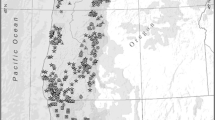Abstract
In 1993, the U.S. Environmental Protection Agency (EPA), as part of the Environmental Monitoring and Assessment Program (EMAP), initiated a sample survey of streams in the mid-Atlantic. A major objective of the survey was to quantify ecological condition in wadeable streams across the region. To accomplish this goal, we selected 615 stream sites using a randomized sampling design with some restrictions. The design utilized the digitized stream network taken from 1:100,000-scale USGS topographic maps as the sample frame. Using a GIS, first- through third-order (wadeable) stream segments in the sample frame were randomly laid out in a line and sampled at fixed intervals after a random start. We used a variable probability approach so that roughly equal numbers of first-, second-, and third-order stream sites would appear in the sample. The sample design allows inference from the sample data to the status of the entire 230,400 km of wadeable stream length in the mid-Atlantic study area. Of this mapped stream length, 10% was not in the target population because no stream channel existed (4%), the stream channel was dry (5%), or the stream was not wadeable (1%). We were unable to collect field data from another 10% of the mapped stream length due to lack of access (mostly landowner denials). Thus, the field data we collected at 509 sites allows inference to the ecological condition for 184,600 km of the mapped stream length in the region.
Similar content being viewed by others
References
Cassel, C.M., Sarndal, C.E. and Wretman, J.H.: 1977, Foundations of Inference in Survey Sampling, John Wiley & Sons, New York, 192 pp.
Cochran, W.G.: 1977, Sampling Techniques, 3rd ed., John Wiley & Sons, New York, 428 pp.
Herlihy, A.T., Stoddard, J.L. and Burch-Johnson, C.: 1998, ‘The Relationship Between Stream Chemistry and Watershed Land-Cover Data in the Mid-Atlantic Region, U.S.’, Water Air Soil Pollut. 105, 377-386.
Horn, C.R. and Grayman, W.M.: 1993, ‘Water-quality modeling with the EPA reach file system’, J. Water Resources Plan. Manage. 119, 262-274
Hynes, H.B.N.: 1975, ‘Edgardo Baldi Memorial Lecture: The Stream and Its Valley’, Verh. Inernat. Verein. Limnol. 19, 1.
Kaufmann, P.R., Herlihy, A.T., Mitch, M.E., Messer, J.J. and Overton, W.S.: 1991, ‘Chemical Characteristics of Streams in the Eastern United States: I. Synoptic Survey Design, Acid-Base Status and Regional Chemical Patterns’, Water Resour. Res. 27, 611-627.
Kish, L.: 1965, Survey Sampling, John Wiley & Sons, New York, 643 pp.
Larsen, D.P., Thornton, K.W., Urquhart, N.S. and Paulsen, S.G.: 1994, ‘The Role of Sample Surveys for Monitoring the Condition of the Nation's Lakes’, Environ. Monit. Assess. 32, 101-134.
Landers, D.H., Overton, W.S., Linthurst, R.A. and Brakke, D.F.: 1988, ‘Eastern Lake Survey: Regional Estimates of Lake Chemistry’, Environ. Sci. Technol. 22, 128-135.
Lazorchak, J.L., Klemm, D.J. and Peck, D.V. (eds.): 1998, Environmental Monitoring and Assessment Program — Surface Waters: Field Operations and Methods for Measuring the Ecological Condition of Wadeable Streams, EPA/620/R-94/004F, U.S. EPA, Washington DC.
Messer, J.J., Linthurst, R.A. and Overton, W.S.: 1991, ‘An EPA Program for Monitoring Ecological Status and Trends’, Environ. Monit. Assess. 17, 67-78.
Overton, W.S., White, D. and Stevens, D.L., Jr.: 1991, Design Report for EMAP, the Environmental Monitoring and Assessment Program, EPA/600/3-91/053, U.S. EPA, Washington DC.
Paulsen, S.G., Hughes, R.M. and Larsen, D.P.: 1998, ‘Critical Elements in Describing and Understanding Our Nation's Aquatic Resources’, J. Amer. Water Works Assoc. 34, 995-1005.
Stehman, S.V. and Overton, W.S.: 1994, ‘Environmental Sampling and Monitoring’, pp. 263-305 in G.P. Patil and C.R. Rao (eds.), Handbook of Statistics 12, Elsevier Science, Amsterdam.
Stevens, D.L., Jr.: 1994, ‘Implementation of a National Environmental Monitoring Program’, J. Environ. Manage. 42, 1-29.
Stevens, D.L., Jr.: 1997, ‘Variable Density Grid-Based Sampling Designs for Continuous Spatial Populations’, Environmetrics 8, 167-195.
Urquhart, N. S., Paulsen S.G. and Larsen, D.P.: 1998, ‘Monitoring for Regional and Policy-Relevant Trends Over Time’, Ecol. Applic. 8, 246-257.
USEPA: 1994, National Water Quality Inventory: 1992 Report to Congress, EPA/841/R-94/001, Office of Water, Washington DC.
Vannote, R.L., Minshall, G.W., Cummins, K.W., Sedell, J.R. and Cushing, C.E.: 1980, ‘The River Continuum Concept’, Can. J. Fish. Aq. Sci. 37, 130-137.
Author information
Authors and Affiliations
Rights and permissions
About this article
Cite this article
Herlihy, A.T., Larsen, D.P., Paulsen, S.G. et al. Designing a Spatially Balanced, Randomized Site Selection Process for Regional Stream Surveys: The EMAP Mid-Atlantic Pilot Study. Environ Monit Assess 63, 95–113 (2000). https://doi.org/10.1023/A:1006482025347
Issue Date:
DOI: https://doi.org/10.1023/A:1006482025347




